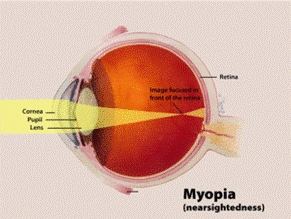Myopia, also known as nearsightedness, is a chronic, progressive disease characterized by excessive eye elongation, risk of associated sight-threatening complications, and a negative powered refractive error. A myopic eye grows too long to be able to focus light correctly on the retina in the back of the eye. Myopia is becoming more prevalent in children, starting at earlier ages and rapidly progressing.
Children with one or both parents who have myopia are more likely to develop it. There is data showing that limited outdoor play and increased screen time and near work contribute to its progression.
Once a child develops myopia, it typically increases about 0.50 diopters per year. Myopia generally stops progressing in the late teens or early twenties, however, some adults still have increasing prescriptions. Those with high myopia are more at risk of developing glaucoma and diseases in the retina.
Myopia Management is achieved through various treatment options:
Orthokeratology: The use of specially designed and fitted contact lenses that are worn at night to temporarily reshape the front surface of the cornea while sleeping. It provides children with corrected vision upon waking and throughout the day, without the need to wear traditional contact lenses or glasses. The lenses focus light in a specific manner on the retina to also slow the progression of myopia.
Soft Multifocal Contact Lenses: Specifically designed soft multifocal contact lenses are worn daily. These lenses produce myopic peripheral defocus on the retina which has proven to slow the progression of nearsightedness. Children as young as 7 years old are successful at inserting and removing the lenses on their own. The lenses provide clear vision and the freedom from glasses.
Atropine Drops: One drop of prescription low concentration atropine used daily at bedtime slows the progression of myopia. The mechanism of action is thought to involve biochemically blocking the signal for eye elongation. The drops have minimal to no side effects. Glasses or contact lenses still need to be worn during the day.

At Wolman Vision and Therapy Center, the MOONLENS is being utilized for orthokeratology. Watch the following video to learn more: